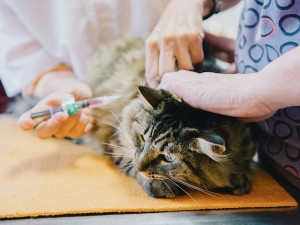How to Identify the Rabies Virus In Cats

Share Article
In This Article:
What Is Rabies in Cats? Signs and Symptoms of Rabies in Cats When Do Cats Show Symptoms of Rabies?
The rabies virus is infamous for the unusual signs it causes as well as its contagious nature. While many people often think of rabies as a stray-dog problem, rabies infections in cats actually outnumber infections in dogs in the United States.
The good news is that these infections are quite rare, especially for indoor cats who are up-to-date on their rabies vaccines. It is still a good idea to familiarize yourself with the signs and risk factors for rabies so you can keep your pets and your human family members safe.

What is rabies in cats?
Many cat parents may not realize that cats are at risk for rabies, so it is important to understand how the virus does its dirty work. Rabies is a virus that can infect all mammals and is found in most parts of the world. The rabies virus is in the genus Lyssavirus, and is known as a neurotropic disease, meaning that it invades nerve cells and eventually makes its way to the central nervous system.
Once there are signs of neurologic disease, the virus is almost always fatal. There are many wild animal species that act as hosts for the virus, including bats, skunks, foxes, and raccoons. In the U.S., these animals are the main source of rabies infections and humans and pets may become infected directly from them. In many countries around the world, stray dogs are another common host for the rabies virus. In the U.S., preventative rabies vaccines and the reduction in stray-dog populations have dramatically reduced this risk. However, stray cats are still common in many parts of the country and can also be a source of infections.
How is rabies transmitted to cats
Rabies transmission is the same for all mammals including cats: through bites from an infected animal. The virus is found in the saliva of infected animals and passes to its next host through a bite or other contact with saliva. Typically cats will get infected when hunting prey, such as bats, that are infected. Other times, they may be infected if attacked by another predator with rabies, such as a racoon, fox, or another cat.
Once the affected animal is bitten, the rabies virus replicates slowly within nerve cells and travels to the central nervous system over weeks or months. There is no easy, reliable way to test for the rabies virus in animals prior to death. Once an animal dies, their brain tissue is tested for the virus. When pets have a risky exposure, like contact with common wildlife hosts or mysterious wounds obtained outdoors, the local department of health provides guidelines on how to manage their care and supervision.
Pets who are up to date on their rabies vaccines are more protected and can be treated differently from unvaccinated animals. Depending on the specific circumstances, the health department may require these animals to be quarantined and observed for signs of rabies for a specific amount of time.
Signs and symptoms of rabies in cats
Rabies progression is variable and not every cat will show all the signs of rabies listed here. The most common signs include:
Prodromal stage: This is the initial phase of the infection where there may be no signs of illness at all, progressing to mild, vague signs like lethargy, fever, and pain or itching around the bite wound. There may also be changes in behavior where shy cats may become extroverted or quiet, calm cats may become aggressive.
Furious stage: Usually within about two weeks, infected animals will start to show dramatic behavior changes including aggression, hypersensitivity to noise and other simulation, agitation, fear, and loss of inhibition. This is the stage when they are most likely to bite and scratch other animals or people.
Paralytic stage: As the virus invades the animal’s brain and central nervous system, progressive neurologic disease occurs. This includes lack of coordination that develops into more generalized paralysis. Animals lose the ability to swallow, which can lead to drooling and foaming at the mouth. Ultimately, the paralysis prevents them from breathing, resulting in death.
When do cats show symptoms of rabies?
It can take weeks or even months for animals to show obvious signs of rabies. There is a lot of variation in the timeline for rabies infections because the virus travels very slowly along the nerves until it reaches the central nervous system.
Depending on where the bite wound occurs, this process will take varying amounts of time. Once a cat shows signs of rabies, the disease usually progresses quickly.
When to seek expert help
If you have questions or concerns related to rabies, it is always best to seek professional guidance right away since this is such a deadly disease and the risk to other animals and people is high. The best way to protect your cats and yourself is to ensure that your cats are up-to-date on their rabies vaccines and to keep them indoors to reduce their risk of contact with wild animals and strays. Be sure to keep up with your cat’s regular check-ups so your vet can update their vaccines as needed.
If your cat does sneak outside and comes back with any wounds, or you find a bat or other common rabies host inside your home, it is very important to contact your vet right away as well as your local department of health to get proper guidance on how to handle their care. Similarly, if you are bitten or scratched by a cat, it is always important to seek medical care and follow their recommendations for wound care and ongoing observation.
Bottom line
Rabies is a highly contagious and fatal virus that can infect all mammals.
Prevention is key so be sure to keep your cat up-to-date on their rabies vaccine and indoors to prevent interactions with wildlife.
Seek medical care right away if your cat is bitten by a wild or stray animal, has mysterious wounds after being outdoors, or has sudden physical or behavioral changes.
References
Fooks, A, et al. “Rabiesopens in new tab,” Nature Reviews Disease Primer, 30 November 2017, vol. 3, no. 17091.
“Lyssavirusopens in new tab,” International Committee on Taxonomy of Viruses, 2025.
“Rabies in the United States: Protecting Public Healthopens in new tab,” Center for Disease Control and Prevention, 21 June 2024.
Rupprecht, C. “Rabies in Catsopens in new tab,” Merck Veterinary Manual, September 2024.

Dr. Amy Fox, DVM
Amy Fox, DVM is a small animal veterinarian in New York City with over thirteen years of experience in a mixture of general practice, emergency medicine, and shelter medicine. A lifelong animal lover, Dr. Fox studied biology in college and then worked as a veterinary nurse before pursuing veterinary school at Cornell University. Her expertise includes surgery, dentistry, and management of chronic conditions, and she is interested in toxicology, pain management, nutrition, care of senior pets, and educational outreach. Dr. Fox also enjoys writing about veterinary medicine and teaching, and her work has previously appeared in Spruce Pets. In her free time, she loves to cook, garden, go for long runs, and hang out with her goofy mixed-breed dog May, who provides never ending comic relief!
Related articles
![cat with cone after vet visit]()
How Often Should You Take Your Cat to the Vet?
Get thy cat to a vet, even if it’s a struggle to get them out the door.
![Young woman showing gray kitten.]()
5 Development Stages You Should Know When You Get a Kitten
What to expect from birth to 16 months.
![Friends play with dog in the park.]()
These 10 States Have the Highest Risk of Pet Illness, New Research Finds
From ticks-borne disease to nasty parasites, these areas have seen the most dog and cat illnesses.
Can Humans Get Cats Sick? What Science Says
What about the other way around?
![A cat with blue eyes standing before a door entrance.]()
How TNR Is Helping Outdoor Cats
Trap-Neuter-Return is the most humane way to keep stray cat populations in check. Here’s how it works.






